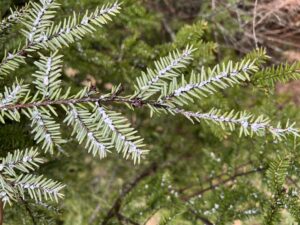New Research Shows Canopy Gaps Promote Hemlock Health as New Management Tool
go.ncsu.edu/readext?958611
en Español / em Português
El inglés es el idioma de control de esta página. En la medida en que haya algún conflicto entre la traducción al inglés y la traducción, el inglés prevalece.
Al hacer clic en el enlace de traducción se activa un servicio de traducción gratuito para convertir la página al español. Al igual que con cualquier traducción por Internet, la conversión no es sensible al contexto y puede que no traduzca el texto en su significado original. NC State Extension no garantiza la exactitud del texto traducido. Por favor, tenga en cuenta que algunas aplicaciones y/o servicios pueden no funcionar como se espera cuando se traducen.
Português
Inglês é o idioma de controle desta página. Na medida que haja algum conflito entre o texto original em Inglês e a tradução, o Inglês prevalece.
Ao clicar no link de tradução, um serviço gratuito de tradução será ativado para converter a página para o Português. Como em qualquer tradução pela internet, a conversão não é sensivel ao contexto e pode não ocorrer a tradução para o significado orginal. O serviço de Extensão da Carolina do Norte (NC State Extension) não garante a exatidão do texto traduzido. Por favor, observe que algumas funções ou serviços podem não funcionar como esperado após a tradução.
English
English is the controlling language of this page. To the extent there is any conflict between the English text and the translation, English controls.
Clicking on the translation link activates a free translation service to convert the page to Spanish. As with any Internet translation, the conversion is not context-sensitive and may not translate the text to its original meaning. NC State Extension does not guarantee the accuracy of the translated text. Please note that some applications and/or services may not function as expected when translated.
Collapse ▲
The hemlock woolly adelgid is a small invasive insect that infests hemlocks. Nestled at the base of hemlock needles, they produce a white woolly mass that look tiny cotton balls on the undersides of branches. The insect has already killed countless hemlocks in the eastern US. Image: Kelly Oten, NC State.
The hemlock woolly adelgid is an enemy of hemlock forests and has been for years. Native to Asia and first detected in the U.S. in the 1950s, it was first found in North Carolina in 1995 and quickly spread throughout NC where hemlock is native. The hemlock woolly adelgid is small, but its impact is great. It has decimated hemlock populations from Georgia to Maine, removing the keystone species and causing cascading ecological impacts.
While insecticides are effective, they’re not practical for protecting trees in the forest setting. It can be difficult to access trees growing in often remote and mountainous terrain, there are personnel and budgetary limitations, and insecticides require repeated applications for long-term protection. Therefore, sustainable management is essential to the survival of hemlock in our forests.
This effort has largely focused on biological control through the introduction of predators from the adelgid’s native range. However, an important piece of integrated pest management (IPM) is that multiple techniques be used in concert to manage a pest. And now, thanks to a recent publication by researchers with the US Forest Service and NC State University, there is another tool in the hemlock woolly adelgid IPM toolbox: silvicultural release.
Their findings, published in Forest Ecology and Management, show that when a gap is created around a hemlock by removing other trees, hemlocks exhibit greater new growth, fewer dead shoots, and greater diameter growth rate relative to trees without a gap cut around them. Larger gaps result in greater tree health advantages for hemlocks. The authors suggest this could complement biological control.
“For years, we sat in meetings listening to forest resource managers working on the front lines of the hemlock woolly adelgid battle talk about how they wanted a silvicultural tool they could use in combination with other strategies,” says Robert Jetton, associate professor at NC State University and one of the investigators on the project. “Those conversations were the driving force behind our research. Now, those same people are starting to implement our management recommendations.”
Jetton and lead author Bud Mayfield, research entomologist with the US Forest Service and Adjunct Faculty at NC State University, led the collaborative team to accomplish this work. While this paper marks a breakthrough in how we view IPM of hemlocks, their work continues. “It’s exciting and a big step forward for hemlock woolly adelgid integrated pest management,” says Jetton.


